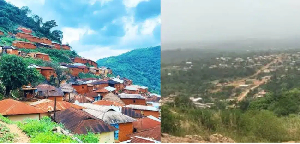In the Volta Region of Ghana lies an indigenous community often referred to by tourists as “The Hanging Village.” Located in the Hohoe Municipal District, the village features houses arranged in rows on terraces, creating a striking visual effect.
Historical records indicate that the Ewes, an ethnic group from West Africa, settled in this area after fleeing tyranny in Benin. During a period of conflict, the Ewes sharpened stones to make weapons, but the battle was ultimately avoided.
The oppressed people sought refuge in the hills, where they lived in caves for many years. These caves, located near the modern border with Togo and close to the Wli Waterfalls, are known as the Likpe Caves.
The Likpe Caves are situated 8 kilometers north of the Wli Falls and were reportedly used as a hideout during the Ashanti war. Since the 1980s, however, the caves have been demystified and are now open to tourists.
There are six ancestral caves, located 20 meters below the surface, each accessible separately. The hike to the caves is physically demanding, requiring sturdy walking boots. Visitors can also take a side trip to the picturesque Wadjakli Waterfall, which, along with the caves, offers a spectacular view of the landscape.
Near the Hanging Village is Kyabobo, pronounced “Chyabobo,” Ghana’s newest national park, situated on the border with Togo in the northern part of the Volta Region. Kyabobo is located in the Nkwanta District and sits between Ghana and Togo. The park is home to the Leboum Waterfalls and the Breast Mountains, both managed by the Wildlife Division of the Forestry Commission of Ghana.
Visitors to Kyabobo have a wide range of activities to choose from, including hiking, visiting waterfalls, biking, camping, canoeing, exploring villages, wildlife viewing, and river tubing. On the Togo side of the border, the park connects to Fazao National Park, offering even more opportunities for exploration.
The park’s landscape is characterized by rolling hills, some of which are quite steep, and dense foliage. Experts recommend spending at least three days in the area to fully appreciate the natural beauty and numerous activities available.
While the park is home to various animals, including elephants, leopards, buffalo, waterbuck, and several primate species, the dense forest can make wildlife sightings a bit challenging. However, visitors may still encounter smaller wildlife like butterflies, bushbuck, birds, and duikers. The park’s symbol is the Rock Hyrax, a large rodent commonly found in Ghana. Although sometimes sold as kebabs along the roadside, there is a good chance to see them alive in the park.
Mount Kyabobo, Ghana’s second-highest mountain, is also within the park, offering visitors stunning views of Lake Volta. The park is situated in a transition zone between tropical rainforest and tree savanna, supporting a diverse range of wildlife, including elephants, leopards, buffalo, waterbuck, primates, bushbuck, duikers, and the Rock Hyrax.
A survey of the park has documented at least 500 species of butterflies and 235 species of birds.
So the next time you are in Ghana, be sure to stop by this intriguing village for an unforgettable experience.
General News of Monday, 2 September 2024
Source: face2faceafrica.com













